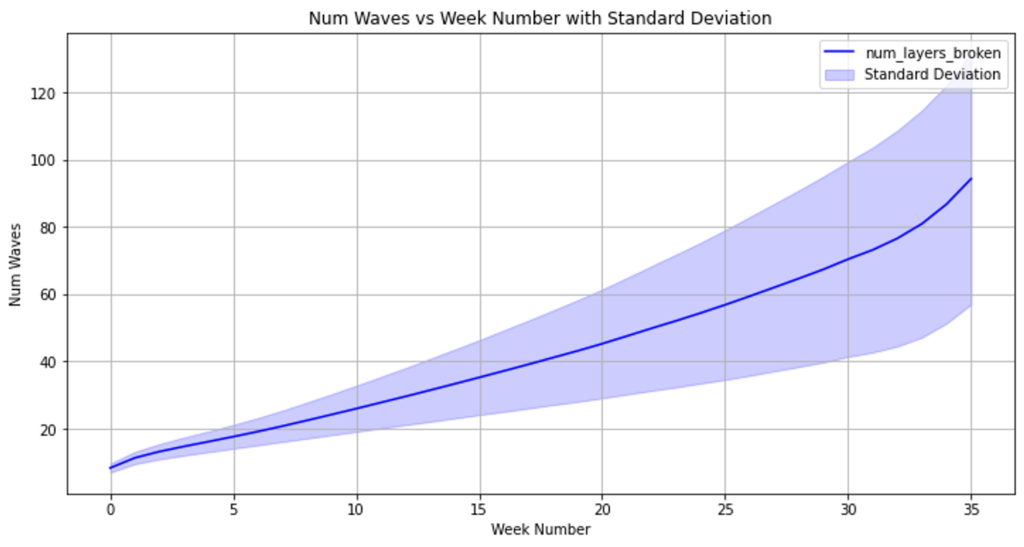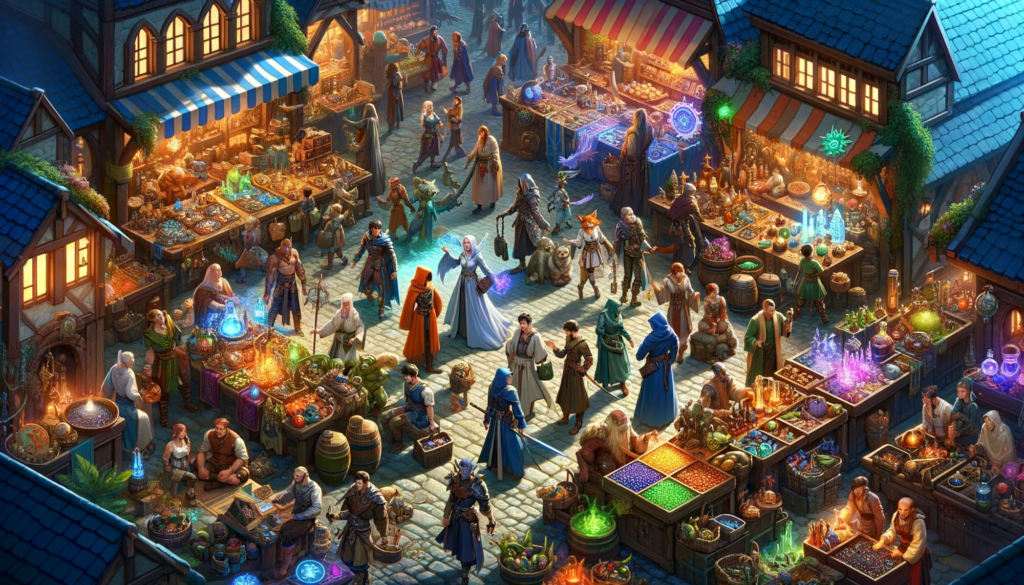Authors: Linas Stankevicius, Stylianos Kampakis

Simulation Role in Games
Game economies are complex. Think of them like a giant puzzle where every piece affects the others in unexpected ways. For game developers, figuring out what will happen in their game’s economy in the future is tough. It’s almost like trying to predict the future, which nobody can do perfectly. But there’s a helpful way to get a better idea of what might happen: using simulation and modeling.
Imagine a game economy as a busy city. Everything is connected. The actions of each player, like the people in the city, can change things in big or small ways. Now, how do you make sure this city runs smoothly and keeps everyone happy? You can’t just guess; you need a smart plan.
This is where simulation and modeling come in. They let game developers ask “what if” questions. What if we add a new item to the game? What if we change how players earn points? By simulating these scenarios, developers can see potential problems before they happen. It’s like having a crystal ball that shows you different futures based on what choices you make today.
These tools are not just for fixing problems. They’re also great for trying out new, creative ideas safely. Developers can experiment in the simulation without risking the actual game. It’s like having a sandbox where you can build and test all sorts of things without any real-world mess.
While we can’t predict everything about a game’s economy, simulation and modeling give us a way to understand it better. They help make games more fun and fair for everyone. As we explore this topic, we’ll see how these tools can help us make better decisions in-game economies.
Time as a Balance Gauge

Time is a universal parameter, both in the real world and in-game economies, that plays a crucial role in determining rewards and progress. Just as we measure our work in hours and receive compensation accordingly, time in games often dictates how rewards are distributed and achievements are unlocked. This concept of time as a measure and a resource is central to understanding and shaping game economies.
In the real world, we’re familiar with the concept of working a certain number of hours to earn our wages. This same principle translates into game design. Time becomes a currency that players spend to achieve goals, whether it’s leveling up, acquiring resources, or climbing the ranks in competitive play. A player might need to invest a certain number of hours to gather materials for crafting a weapon or to reach a desired rank in competitive play. This investment of time is a trade-off, where players exchange their real-world time for in-game progress and rewards.
Treating time as a resource in games also means recognizing it as a ‘sink’ – a necessary investment for gaining something valuable in the game. Unlike traditional currencies or resources in games, time cannot be replenished or accelerated in the same way, making it a unique and valuable commodity. Players’ willingness to invest time can be a measure of their engagement and commitment to the game.
In simulation and modeling, time is a powerful parameter that helps developers understand the pacing and balance of their game. For example, if players can level up too quickly, it might indicate that the game is too easy or lacks depth. Conversely, if leveling up is excessively slow, it could frustrate players and lead to disengagement. Similarly, understanding how much in-game wealth players can accumulate within a certain time frame helps in assessing whether the game’s economy is balanced or if it’s prone to inflation or other issues.
By using time as a filter in simulations, developers can fine-tune the game’s economy, ensuring that the pace and scale of rewards align with the desired player experience. They can answer questions like: Is leveling from 1 to 10 in a day too fast or too slow? Is earning 1 million gold by ‘farming’ monsters for an hour balanced, or does it disrupt the game’s economy? These insights are crucial for creating a game that is both rewarding and challenging, keeping players engaged and invested over time.
Time is not just another metric in game design; it’s a fundamental aspect that influences how players interact with and perceive the game’s world. By carefully modeling and simulating how time affects game economies, developers can create more immersive, balanced, and engaging gaming experiences.
Scenario: Waves of Monsters

Imagine a game where players join forces to defeat waves of monsters by tapping on their screens. Each stage of the game is filled with monsters that players need to fight off using weapons. Each weapon is unique – some are strong and can take out lots of monsters at once, but they need a break before being used again.
It’s a team game where everyone works together to beat the monsters. Since there are only so many monsters in each wave, players have to plan and play as a team.
Choosing the right weapon, knowing how many monsters are in each wave, and the total number of waves are key to moving through the game quickly. The game also tries to guess how players will use their weapons and how long they need to wait before they can use them again.
The main goal is to figure out the best way to use the weapons and team up with others to get rid of all the monsters in time. The game is easy to pick up but needs smart planning and team play to win.
Game Economies: Simulation and Modelling
Imagine that our gaming community has voted in favor of a longer, more engaging season for the game, with a minimum duration of 9 months. As game designers, we are now tasked with addressing how to optimize the game to ensure it remains compelling and optimized for this period of time.
Let’s overview the building blocks of this particular game economy so we can understand our ‘playing field’:
- Waves: The game features multiple waves.
- Monsters: Each wave is populated by a number of monsters.
- Weapons: Players are equipped with weapons to fight off the monsters.
- Weapon Attributes: Weapons differ in strength and cooldown periods.
- Weapon Effectiveness: Stronger weapons can defeat more monsters at once.
Gameplay Mechanics:
- The main action in the game is to tap the screen to fend off monsters.
- The game requires cooperation, with all players working together to overcome challenges.
- There is a set number of monsters in the game, which must be defeated by all players together.
Objective and Time Frame:
- The central challenge is understanding how the strength of weapons, the number of monsters and waves, and collective player strategies will affect the ability to clear the game within 9 months.
- The game is won if players successfully defeat all waves of monsters in this time.
Providing Context
Initially, we assume that the game will have 500 waves in total, with 5 billion monsters to slay.
At the start, there will be 3 million players. Each player will have a weapon, but not all weapons are the same. Some are more powerful than others. Over time, players can upgrade their weapons, making them more effective at fighting monsters.
Levels Distribution:
- The simulation starts with 11 different levels of weapons.
- The initial probabilities for these levels are set, with a higher probability for the first two levels. This setup suggests that at the beginning, most players have basic or slightly advanced weapons.
- As the game progresses, the distribution of weapon levels changes. This change simulates players upgrading their weapons.
- The simulation uses a formula to gradually increase the probability of higher-level weapons as time passes. This reflects the idea that players are likely to upgrade their weapons as they play the game longer.
General representation of how the distribution of weapon levels might evolve:

- Start: Initially, most players have basic weapons (higher probabilities for lower levels).
- Middle: As time progresses, the distribution starts to shift, with more players upgrading to better weapons.
- End: Towards the end, the probabilities are more evenly spread across different levels, indicating a significant number of players have upgraded to higher-level weapons.
Game Personas:
The gamer types will be divided into normal and extreme users.
Normal Users
These are the average players who participate in the game at a standard or typical level. They represent the majority of the player base.
Normal users might play the game regularly but don’t go to great lengths to progress rapidly. They might have fewer or less advanced weapons compared to extreme users.
In the simulation, normal users are represented by a certain percentage of the total player base. 80% of the players are considered normal users.
Extreme Users
These are the highly engaged or dedicated players who invest a lot of time and effort into the game.
Extreme users might play the game more intensively, striving to upgrade their weapons faster and slay more monsters. They are the players who go above and beyond the average level of engagement.
In the simulation, extreme users are represented by the remaining 20% of the players. They are modeled to have more advanced equipment and a higher rate of slaying monsters.
The pie chart visualizing the distribution of normal and extreme users:

Dropout of Players:
Not all players will stay until the end. Some will stop playing as time goes on. The game predicts this dropout using a formula, expecting a higher dropout rate at the start and a lower one as the game progresses.

How the Game Progresses:
Each week, the game calculates how many monsters are killed based on the number of players, the types of weapons they have, and how many weapons each player uses. This calculation considers both regular players and those who play more intensely.
The game keeps track of how many waves of monsters are killed each week. It then creates a timeline showing this progress. The goal is to see if the players can complete all 500 waves within 9 months.
Outcome:

We can observe that, with the current parameters, the simulation (of 1000 runs) indicates that players can complete approximately 90 waves (with a standard deviation ranging from just below 60 to around 120 waves) over a 9-month period.
Findings
500 Waves with 5 Billion Monsters Each is Too Ambitious with Current Parameters:
- The simulation, after 1000 runs, shows that players are only able to complete about 85 waves on average in 9 months. This is far short of the 500-wave goal.
- The standard deviation, ranging from below 60 to around 120 waves, indicates significant variability in game outcomes. Some runs result in players breaking through fewer waves, while others achieve more, but none come close to the 500-wave target.
- This suggests that the current game parameters, including the distribution and power of weapons, player engagement levels, and dropout rates, are not sufficient for players to realistically complete all 500 waves in the given timeframe.
Adjusting Weapons Distribution for 500 Waves:
- To make the goal of 500 waves achievable, the game could adjust the distribution and effectiveness of weapons. Making powerful weapons more accessible or increasing their effectiveness could help players to break through waves faster.
- Another approach could be to reduce the recharge time or increase the monsters-slaying capacity of each weapon, allowing for quicker progression through the waves.
Increasing Difficulty for a 100-Wave Game:
- If the game is modified to have only 100 waves, the current weapon distribution might make the game too easy and less challenging.
- In this scenario, making the weapons less powerful or more challenging to obtain could maintain a level of difficulty that keeps players engaged and prevents the game from being completed too quickly.
Adjusting Weapons Distribution for 500 Waves:
- Given the ambitious goal of 500 waves, the game might benefit from a dynamic adjustment mechanism. This could involve monitoring player progress and making in-game changes to help players when they are falling behind.
- If players are not progressing as expected, the game could introduce events or rewards that make obtaining or upgrading weapons easier. This approach would keep the game balanced, ensuring it remains challenging but not impossible, and could adapt to varying levels of player engagement and progression rates.
Conclusion: Game economies and simulations
As we’ve explored, the intricate world of game economies mirrors the complexity of real-world economics. The use of simulation and modeling tools is not just a theoretical exercise; it’s a practical necessity for creating balanced, engaging, and sustainable gaming experiences. These tools enable developers to foresee the consequences of their decisions, ensuring that the virtual economies they create are as dynamic and robust as their real-world counterparts.
However, mastering the art of tokenomics in game development is no small feat. It requires a deep understanding of both gaming mechanics and economic principles. Whether you’re a game developer grappling with the challenges of creating a balanced economy, or a startup venturing into the world of digital economies, navigating these waters can be daunting.
This is where expert guidance can make a significant difference. If you find yourself needing assistance in shaping the tokenomics of your game or digital project, don’t hesitate to reach out. With the right expertise, you can transform your game’s economy from a complex puzzle into a thriving, engaging ecosystem that players will love. Contact us for tailored advice and solutions that can help you unlock the full potential of your game’s economy.

